
Even with summer not having started officially yet (6/21), the sun and the light are fabulous.

Even with summer not having started officially yet (6/21), the sun and the light are fabulous.
Imagine this: It’s the beginning of the 1960s. You are a young aerospace engineer. Your father-in-law has given you a lot in the Santa Monica Mountains above Mulholland Drive, with a spectacular view and a 45 degree slope. You want to build a house there, but everybody tells you that this is impossible. Your budget is limited. What do you do?
Leonard Malin (who was the young man) found help in architect John Lautner. Lautner already had a reputation as the best architect for the most difficult building lots. I can just imagine those two getting together, with Mr. Malin stating: “I have the lot. I have $30.000. I want to live there. Do what you want. And, by the way, the end result does not need to look like a house.”
Okay, I made that last sentence up. But he could have said it, because the house, better known today under the name “Chemosphere,” looks like this:
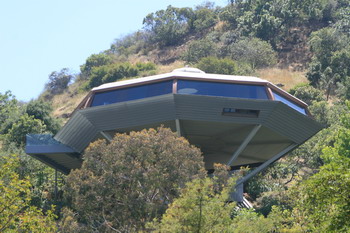
Imagine living there. What fun.
Getting ready for an well deserved afternoon nap:
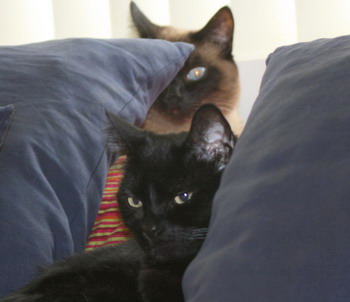
But then every nap is well deserved.
My first visit to the Los Angeles Zoo in Griffith Park was a bit of a disaster. Not knowing then that the park is a bit larger than usual (as far as parks go) I imagined that a pleasant stroll on a lovely Sunday would be a perfect way to pass the time. Nobody pointed out to me that my attire of summer dress and high heeled sandals might not be quite the proper hiking gear; in fact, nobody told me that the pleasant stroll I had envisioned would be a hike of two miles.
Upon finally arriving at the zoo I was in pain. My feet were burning and throbbing; my teeth were hurting, too, from grinding them. I could do nothing about the pain in my jaw, but for the feet there was an instant cure: The flamingo pond opposite the entrance. I hobbled over there, took off my shoes and stuck my feet into the water. I am sure I heard a slight hissing sound as they sunk into the silken cool wetness. I closed my eyes. Sheer bliss.
When I opened my eyes again, all those flamingos had turned their heads towards me. I swear, the collective look of disgust on their faces said very clearly: “Good grief, woman, we drink that water!”
I am not sure whether they had a flamingo pond at the Old Zoo. Actually I am not sure what types of animals they had there at all, because it must have been a pretty small place. It certainly was a zoo of the type one (luckily) does not find any longer – with small cages and stockades that the animals on exhibit were just stuck into.
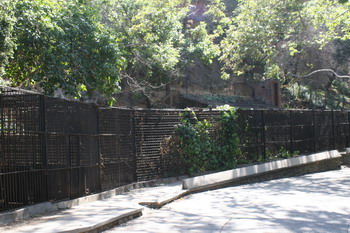
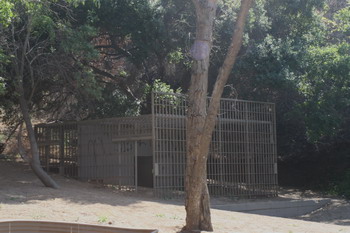
When, in the middle of the ‘60s, the zoo moved to its new and present location about a mile away, the abandoned site just sat there. A while later the area was transformed into a picnic ground with lovely lawns. The old grottoes were fitted with barbecue pits, tables and benches – voila, a perfect setting for an outing with the family and lots of exciting places for the kids to explore.
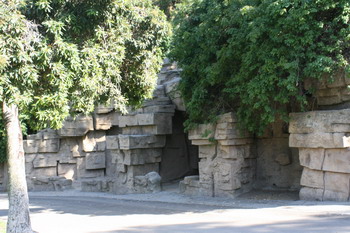
These grottoes were also used as a location for “Anchorman: The Legend of Ron Burgundy.” Yes, the wacky scene with Christina Applegate, Will Ferrell, the bears and Baxter the dog was shot here, because neither the L.A. nor the San Diego Zoo could quite stomach the idea of having the Hollywood madcaps on their premises.

Detail of Gamble House in Pasadena
In February 2008 the BCMA (Broad Contemporary Art Museum) opened next door to the LACMA (Los Angeles Country Museum of Art). Both museums share the same campus, which is still undergoing a major overhaul.
Apart from yet another abbreviation the BCMA brought not only a rather interesting collection of modern art to the city, but also an installation outside on the piazza between the two museums: “Urban Light” by Chris Burden.
This installation, consisting of 202 street lamps, most of them actually originating from Los Angeles, is one of my favorite pieces. There are new aspects from each and every angle, light and shadow paint pictures of their own, surrounding buildings (even those not connected to the museum) come into play for new and surprising compositions.


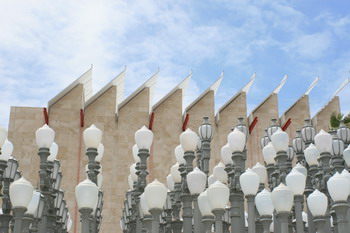
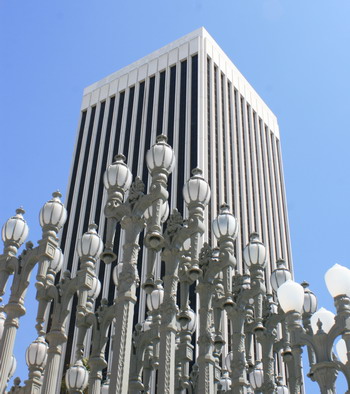


And yes, they do light up at night. One of these days I’ll have to go down to Wilshire on a balmy summer night for a new series of photos.
Down by the river everybody is busy hatching the new families. Some black-necked stilts were quite fast this year; their tiny little fluff balls are already out and about. As every year the parent birds are on high alert: Anything larger than a stilt is a potential danger to the chicks.
What do black-necked stilts (being rather small and fragile birds) do to protect their young as long as they can’t fly? As soon as the parent birds see anything dangerous approaching, they start to lure the assumed predator away.
Hey, I am here. HERE!
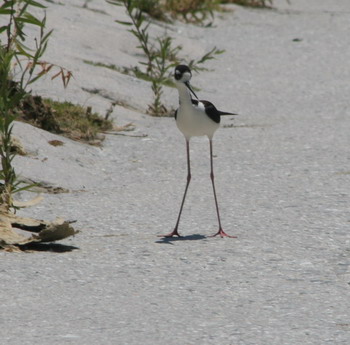
Look, something is wrong with me.
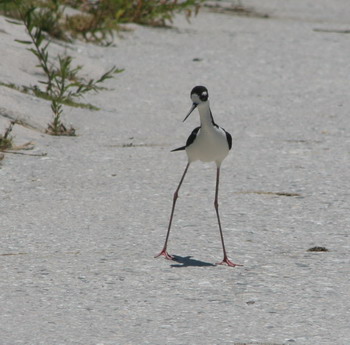
I can’t fly.
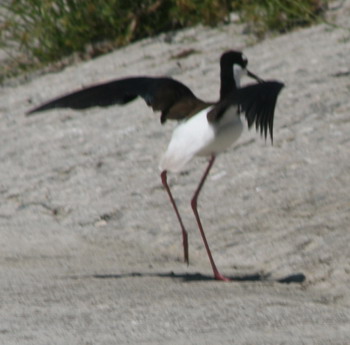
My legs are giving up.
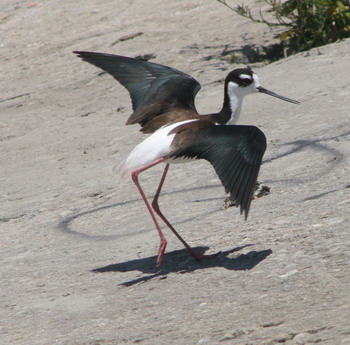
I’m done – broken wing, can’t run any more.
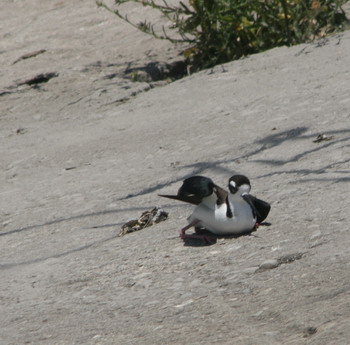
If the assumed predator now approaches the stilt, the bird musters up the last remnants of strength to fly again. Not very far, then it has to land again… that wing, you know… just a bit farther away from the spot where the little ones are hiding. This game continues until the stilt calculates that the distance to the hiding place is long enough – end of operation, miracle cure, the stilt flies away and returns to the spot where the chicks are safely tucked away, in a nice grass thicket or such. There the other parent joins in to give the “all clear” signal.
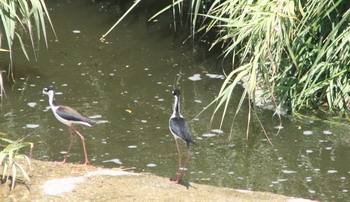
# 1 has left cover.

# 2 made it safely back too – hurray, the family is united again.


This parking space comes with your choice of carts.
This is not a California scrub oak in full bloom – this is a California scrub oak chosen by a Cup-of-Gold Vine (Solandra maxima) as a perfect climbing place.

The old Aztecs knew their Solandra quite well, albeit under the name ‘Tecomaxochitl’. They used the leaves to cook them up with cocoa; the resulting brew was then drunk as a love potion. I can just imagine the novice in the kitchen listening to Granny mumbling: “Be careful, dear, don’t give him too much of it – his body will dry out and he will die of too vigorous lovemaking.” Hmm… what a way to go.
Actually, the members of the Solandra family are an interesting bunch – they range from the Deadly Nightshade to the potatoes, including tomatoes, eggplant, paprika, chili peppers and tobacco.
And yes, the flowers and leaves of the potato plant are quite toxic, too, as the poor farmers in Germany learned when Frederick the Great (1712 – 1786) decreed that they had to plant this newfangled crop on their fields. Frederick needed food for his people, and even more so for his army – plenty of food, and cheap to boot. The potato was perfect. Unfortunately somehow nobody explained to the farmers which part of the plant was edible, so they cooked the green parts. Bon appetit – not. Once the initial confusion about the edible parts of these new crops was sorted out, the potato thrived and the people with it.
Actually, I met both members of the family in one day on Catalina Island: The strikingly beautiful bloom (diameter 4 inches) in the morning in the Botanical Garden, the rather more humble but tasty potato in the evening on my dinner plate. I enjoyed both very much.
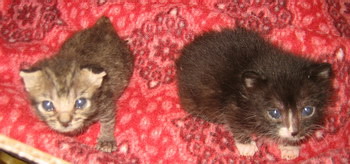
According to the Los Angeles Animal Services the city is populated at any time by approximately 26,000 – 48,000 stray dogs and 3 million feral cats.
In 2006 alone 46,000 animals found their way into the Los Angeles shelters, where they are kept for 52 days plus 7 additional days in the hope that they will be adopted. In 2006 this hope did not come true for 28 percent of the dogs and 57 percent of the cats. They were euthanized.
Enter the private and non-profit organizations, who run no-kill shelters for strays and also rescue animals from the city shelters to find new homes for them. These places, like the city shelters, are constantly battling with overcrowding and under funding. Most of them could not survive at all, where it not for volunteers giving their time (and money) to keep the safe havens for dogs and cats alive and operating.
The two tiny critters in the photo are foundlings, delivered to the Sante D’or Foundation on Sunset. There they will be available for adoption, together with their feline friends, rabbits and sometimes dogs, also looking for new homes.